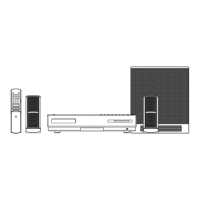8
Example:
4 Press [SCAN MODE] repeatedly and
select the appropriate signal type.
• According to the settings in step 1, select
“576I”, “576P”, “720P”, or “1080I” for
component output. Corresponding resolution
with the TV can be selected for HDMI output.
•Despite the setting, “576I” is output when the
TV is connected to the composite or [S-
VIDEO] terminal.
• When the TV is connected to the HDMI
terminal, selelect AUTO for normal usage.
• Select 576P, 720P, 1080I, or 1080P as
needed.
5 Set the initial settings for
connection. (Refer to
“CONNECTION SETTING” on page
53)
NOTE
•Video signals cannot be changed even if you press
[SCAN MODE] during startup or SD/disc playback.
• “576”, “720”, and “1080” refer to the number of
scanning lines. Generally, the larger number, the
better will be the picture quality.
• “I” refers to the interlaced format. “P” refers to the
progressive format. A better picture can be obtained
in the progressive format than in the interlaced
form
at.
• When an HD video signal (720P, 1080I, 1080P) is
output, the “HD” indicator lights up.
• When “576P” or “720P” or “1080P” is selected, the
“q” indicator lights up in the display window.
• When playback of an SD/disc is stopped, the
selected video signal type is displayed in the on
screen display for a while.
Example:
NOTE
• Even if the main unit is turned off, the video signal
type setting is stored.
•The output signal type from the SCART terminal is
confined to only the composite signal.
576I
:
1080pCurrent resolution

